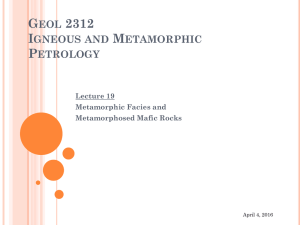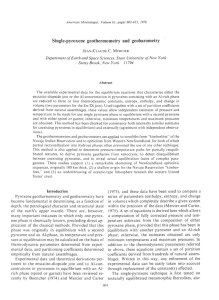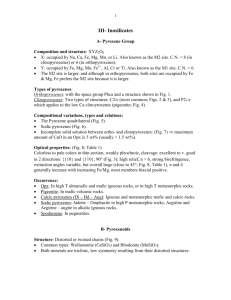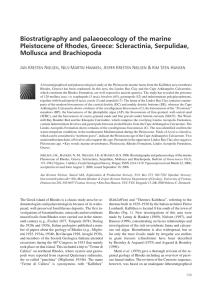Isograds and Metamorphic Facies
advertisement
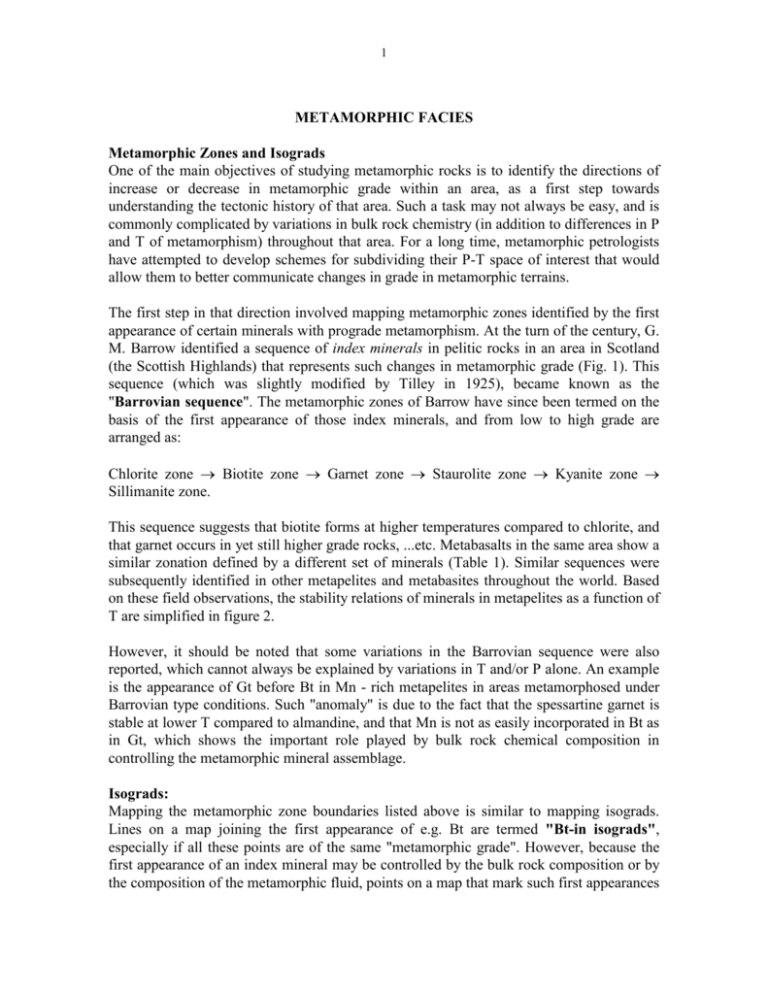
1 METAMORPHIC FACIES Metamorphic Zones and Isograds One of the main objectives of studying metamorphic rocks is to identify the directions of increase or decrease in metamorphic grade within an area, as a first step towards understanding the tectonic history of that area. Such a task may not always be easy, and is commonly complicated by variations in bulk rock chemistry (in addition to differences in P and T of metamorphism) throughout that area. For a long time, metamorphic petrologists have attempted to develop schemes for subdividing their P-T space of interest that would allow them to better communicate changes in grade in metamorphic terrains. The first step in that direction involved mapping metamorphic zones identified by the first appearance of certain minerals with prograde metamorphism. At the turn of the century, G. M. Barrow identified a sequence of index minerals in pelitic rocks in an area in Scotland (the Scottish Highlands) that represents such changes in metamorphic grade (Fig. 1). This sequence (which was slightly modified by Tilley in 1925), became known as the "Barrovian sequence". The metamorphic zones of Barrow have since been termed on the basis of the first appearance of those index minerals, and from low to high grade are arranged as: Chlorite zone Biotite zone Garnet zone Staurolite zone Kyanite zone Sillimanite zone. This sequence suggests that biotite forms at higher temperatures compared to chlorite, and that garnet occurs in yet still higher grade rocks, ...etc. Metabasalts in the same area show a similar zonation defined by a different set of minerals (Table 1). Similar sequences were subsequently identified in other metapelites and metabasites throughout the world. Based on these field observations, the stability relations of minerals in metapelites as a function of T are simplified in figure 2. However, it should be noted that some variations in the Barrovian sequence were also reported, which cannot always be explained by variations in T and/or P alone. An example is the appearance of Gt before Bt in Mn - rich metapelites in areas metamorphosed under Barrovian type conditions. Such "anomaly" is due to the fact that the spessartine garnet is stable at lower T compared to almandine, and that Mn is not as easily incorporated in Bt as in Gt, which shows the important role played by bulk rock chemical composition in controlling the metamorphic mineral assemblage. Isograds: Mapping the metamorphic zone boundaries listed above is similar to mapping isograds. Lines on a map joining the first appearance of e.g. Bt are termed "Bt-in isograds", especially if all these points are of the same "metamorphic grade". However, because the first appearance of an index mineral may be controlled by the bulk rock composition or by the composition of the metamorphic fluid, points on a map that mark such first appearances 2 may not always be of the same metamorphic grade. Because identifying points of "equal metamorphic grade" in the field is difficult, it may be more practical to redefine the term isograd as: "A line on a map connecting all points marking the first appearance of an index mineral in a metamorphic unit of a certain chemical composition" Characteristics of isograds: (i) Isograds have a tendency to be concentric around the heat source (?) (ii) They are influenced by the chemical composition of the rock. One example is that of Gt and Bt (discussed above). Note that interpolation between the different rock types to draw isograds is common practice. (iii) Isograds are not isotherms; variations in the composition of the fluid phase attending metamorphism will play a crucial role in the appearance or disappearance of certain phases. Thus two rocks of identical composition, metamorphosed under identical P and T gradients, may develop different isograd patterns depending on the composition of the fluid in each area. An example of that is the distribution of wollastonite (Wo) in a contact metamorphic aureole, which depends on the XCO2 value of the fluid attending metamorphism. If the fluids are rich in CO2, the formation of Wo at the expense of Qz and Cc will be suppressed, and vice versa. It is also quite common for an index mineral used to define an isograd to have a very wide P-T stability field, which allows it to coexist stably with other index minerals. An example for such mineral is biotite within the Barrovian sequence, which is stable in the zones Bt through Sill (Fig. 2). Such minerals are known as "running through minerals". The occurrence of running through minerals, along with the properties of "isograds" (as practically drawn on maps) do not make index minerals very useful for determining the exact P and T conditions of metamorphism at different points in a mapped area. It is therefore obvious that the mineral assemblage rather than one index mineral is more useful for such estimates. Comparison of mineral assemblages across metamorphic zone boundaries in one unit, coupled with petrographic and textural analysis, may lead to the identification of metamorphic reactions that have taken place in those rocks within the study area. For a specific composition of reactant and product minerals, each of these reactions will take place at a specific T (for a given P and known composition of the fluid). Such reactions are therefore more valuable for estimating metamorphic T than the mere identification of index minerals. Lines on a map connecting points where a certain reaction in a particular rock type is known to have taken place are hence called "reaction isograds". Facies: Dividing the P-T space of metamorphism to several subdivisions independent of the composition of the metamorphosed rock would immensely facilitate communication among petrologists regarding the grade of metamorphism. In 1915, Eskola introduced the concept of metamorphic facies to accomplish such a classification. Eskola's facies 3 (originally 7 + 1 in number; Fig. 3) were based on mineral assemblages (in mafic rocks) rather than index minerals. In 1966, Fyfe and Turner defined the metamorphic facies as: "A set of metamorphic mineral assemblages, repeatedly associated in space and time, such that there is a constant and therefore predictable relation between mineral composition and bulk rock chemical composition". More simply, a facies may be defined as: "A group of mineral assemblages, each developing in a rock of specific chemical composition, and is characteristic of the P and T under which the rocks were metamorphosed". The corollary of these definitions is that if we know the bulk composition of the rock and the P and T at which it crystallized, we should be able to predict the mineral assemblage. The other corollary is that every possible mineral assemblage stable at a specific range of P and T could be a facies. Evidently, this would lead to an infinite number of facies that would lead to more confusion!! It should also be noted that the facies concept is inexact, with the problems of some mineral assemblages "running through" two or more facies for certain rock compositions (e.g. muscovite + biotite in the Barrovian sequence; Fig. 2), and of some facies better defined for one rock type than another,... etc. Such confusion led some scientists to suggest that the facies concept be abolished (e.g. Winkler, 1979), and that the P-T realm be divided into very low, low, medium and high grades. Nevertheless the facies concept has survived and still remains popular. The facies boundaries are defined by metamorphic reactions which are considered responsible for the change in the mineral assemblage from one facies to the other. Because Eskola's work was mostly on mafic rocks (metabasalts), most facies boundaries were defined by reactions in mafic rocks (Fig. 4). However, note that every rock type may be characterized by a very large number of reactions responsible for observed changes in the mineral assemblages. If all these reactions were used for such subdivision, it will result in a very cumbersome classification with a very large number of facies (and subfacies). A simplified subdivision that is based on a limited number of mineral assemblages commonly encountered in some rock types is therefore necessary. Such is the status of the metamorphic facies concept (Tables 2 and 3). Characteristics of metamorphic facies: (1) Facies boundaries are defined by the appearance or disappearance of a mineral or group of minerals, and not a specific P and T. The boundaries betweeen the different facies are therefore transitional in many cases, as the compositions of the minerals and/or fluids in question vary due to bulk rock chemical control (and other factors as well). Such variations in turn affect the P-T location of the boundary reactions. (2) Minerals of the paragenesis should have formed at the same time during one metamorphic event (self evident!!) (3) Rocks of an individual facies form in the same range of P and T. 4 (4) The mineral assemblages, though restricted to specific rock compositions, are not restricted to any areas, and should occur repeatedly in space and time (i.e. should be widely distributed). (5) The term facies has no textural connotations. It cannot be used to classify individual rocks, and is independent of the modal contents of the different minerals constituting the paragenesis. (6) Most of the reactions used to define the facies boundaries have steep P-T slopes (Figs. 3 & 4), and are strongly dependent on the fluid composition (as will be discussed later). The Metamorphic Facies The eight metamorphic facies originally defined by Eskola were the greenschist, pyroxene hornfels, amphibolite, granulite, sanidinite, glaucophane schist (blueschist) and eclogite facies. Since then a number of other facies and "subfacies" have been introduced. In these notes, I summarize the key mineral assemblages in mafic and pelitic rocks of nine facies and some of their subfacies. Note that the P-T ranges given for each facies are very rough estimates: Facies are defined by mineral assemblages not P-T ranges !! Note also that the prehnite-pumpellyite and pumpellyite-actinolite facies are collectively termed "subgreenschist facies" whereas the lawsonite albite (or lawsonite blueschist) and epidote blueschist facies are considered subfacies of the glaucophane schist facies (blueschist facies) of Eskola. (1) Zeolite facies: (~150-250°C; P < 3 or 4 kbar?) defined by the occurrence of zeolites developed in mafic igneous rocks, but not identifiable in metapelites Under conditions of high XCO2 zeolites become unstable!. equivalent metasediments (anchizonal metamorphism): possible interlayered illite and paragonite (Ill/Pg), Corrensite (interlayered Chl/Sm), no Ctd. (2) The subgreenschist facies: (a) Prehnite-pumpellyite facies: prehnite and pumpellyite in metabasites. best developed in mafic rocks (metabasites) metamorphosed at T of 200-300°C equivalent metasediments : low anchizone defined by the occurrence of illite, rectorite (interlayered paragonite/smectite) ± corrensite (interlayered chlorite/smectite). (b) Pumpellyite-Actinolite facies: Pmp + Act in mafic rocks equivalent metasediments: high anchizone (no interlayered chlorite/smectite (Chl/Sm), no Ill/Sm, no rectorite (Pg/Sm), no Ill/Pg, possibly marked by the first appearance of Ctd?) 5 (3) Blueschist facies: (a) Lawsonite-albite subfacies/Lawsonite blueschist subfacies*: Lw + Ab + Chl ± Pmp or Act or Gln* Metasediments: Carpholite (Car (Fe,Mg) Al2Si2O6(OH)4) + Chl + Ill or phengite (Ph, Si - rich, Mg - bearing muscovite) + Pg Characterized by the lack of biotite in metasediments and metabasites (phengite instead of Bt). (b) Epidote-blueschist subfacies: Gln + Ep + Gt/Chl + Ph ± Act in metabasites higher T than Lw-Ab subfacies. metasediments: Ctd + Pg + Chl + Ph Ctd + Pg + Gln + Ph Ab + Gln + Chl + Ph,... etc. Characterized by the lack of biotite in metasediments and metabasites (phengite instead of Bt). (4) Eclogite facies: Garnet + Omph, no Ab, no Lw (epidote or grossular garnet are the stable Ca Al silicates) metasediments: Talc + Kyanite + Phengite (Si-rich muscovite), No chlorite. Coleman et al. (1965) pointed out that the assemblage Gt + Omph has a wide stability field, and that eclogites occur in different geologic settings. Coleman et al. accordingly subdivided eclogites into three groups (Fig. 6): Type A: eclogites that form in the mantle and are brought up to the surface with kimberlites in diatremes. Garnets in these eclogites are rich in pyrope. Type B: eclogites that form in the lower crust and are associated with gneiss terrains (granulites and high grade amphibolites). Garnets in this group are rich in grossular and almandine. Type C: eclogites that form at relatively low temperatures in what are now known as subduction zones. These eclogites contain almandine rich garnet and are associated with blueschists. (5) Greenschist facies: Act + Chl + Ab ± Ep ± Cc in metabasites metasediments: Chl + Ab + Bt + Musc ± And/Ky ± Cc (Ctd, Pg also possible depending on rock composition) (6) Epidote amphibolite facies: Ep + Amph (Act/Hb) + Plag (Ab/Olig) ± Chl/Gt in mafic rocks. Bt + Gt (Alm) + Plag (Ab/Olig) + Chl + Musc (Ctd also possible) in metasediments. (7) Amphibolite facies: Amph (Hb) + Plag (Andesine) ± Gt ± Ep ± Di metapelites: Gt + St + Musc + Bt ± And/Ky/Sill (Crd possible). 6 (8) Granulite facies: Plag + Hypersthene (Hy) + Diopside (Di) + Gt + Spinel metapelites: Perthite + Plag + Sill + Gt ± Hy (Fe-Crd + Gt characteristic of low P granulites). (9) Sanidinite facies: Plag + Hypersthene + Augite + Tridymite in mafic rocks Sanidine + Crd + Spinel + Hypersthene + Sill in metapelites 650-850°C, very low P. Facies to be abolished: albite-epidote-hornfels facies, Hb- hornfels facies and pyroxene hornfels facies. As can be seen, these facies have the same mineral assemblages as the greenschist, amphibolite and granulite facies, the only differences being the textural term "hornfels" suggesting that they form by thermal metamorphism. As such, these terms are inappropriate and should be abolished. Facies series concept (Miyashiro, 1961): As an area is subjected to regional metamorphism, several facies boundaries may be crossed, and the metamorphic map of that area would show zones belonging to several facies. In 1961, Miyashiro pointed out that there is a close spatial and temporal association between certain types of facies and certain geologic environments, based on his field work in the Sanbagawa mountain belt of Japan (see the metamorphic zones later mapped by Banno for this area; Fig. 7). Miyashiro defined a metamorphic facies series as: "A mapped series of facies or subfacies bounded by isograds, representing a progressive metamorphic sequence that is characteristic of some tectonic regime". Miyashiro originally identified three facies series (Table 5; Fig. 8): (1) high P/T series: zeolite Prh - Pmp Pmp - Act blueschist eclogite (e.g. Sanbagawa, Franciscan, western Alps), (2) intermediate P/T series: zeolite Prh Pmp greenschist epidote amphibolite amphibolite granulite (e.g. Barrovian sequence, also known as Dalradian), (3) low P/T facies series zeolite greenschist amphibolite granulite (e.g. Abukuma, Buchan). Miyashiro (1973) added two more facies series (Table 6, Fig. 9). P-T-time paths in relation to facies and facies series: Metamorphism is a dynamic process viewed through time. Accordingly, each rock has a history of evolution in P-T space which allows it to "pass" through several facies before reaching the peak pressures and temperatures. The same rock also passes through other facies on its way back to the surface. However, by convention, the "facies" of such rock is taken as that defined by its predominant mineral assemblage, which is usually that which formed when it attained peak conditions. Accordingly, a rock may be described as a blueschist with a greenschist facies overprint, if peak conditions were attained within the blueschist facies,... etc. 7 A metamorphic facies series only represents the progressive sequence of metamorphic facies observed in the field. A facies series therefore does not necessarily represent the actual P-T path followed by any rock in that field area. Summary of key mineral assemblages characteristic of the different metamorphic facies Facies Zeolite Mafic zeolites Prehnite pumpellyite Prh – Pmp – Chl – Ab Pumpellyite actinolite Pmp – Act – Chl – Ab Greenschist Act – Chl – Ab – Ep Epidote amphibolite Ep – Hb/Act – Olig – Chl/ Gt Hb – Plag – Gt ± Ep/ Cpx Amphibolite Granulite Lawsonite albite Epidote blueschist Eclogite Gt – Hb – Cpx – Opx – spinel Lw – Ab – Chl ± Gln/Act/Pmp Gln – Ep – Chl – Ab ± Gt Gt + Omp ± Ep (no Ab, no Lw) Pelitic (+ Qz) mixed layer clays (low anchizonal) mixed layer clays (low anchizonal) no mixed layered clays (high anchizone), illite only Chl – Bt ± Ctd ± Gt (Mn – rich) + Musc Bt-Gt-Chl Bt – Gt – St - Musc ± And/Ky/Sill; Crd in low P zones Kapr- Plag – Gt – Sill – Opx. (Crd possible) Car – Chl - Ph Gt – Ctd – Ph, no Bt! Tc – Ky – Ph.
